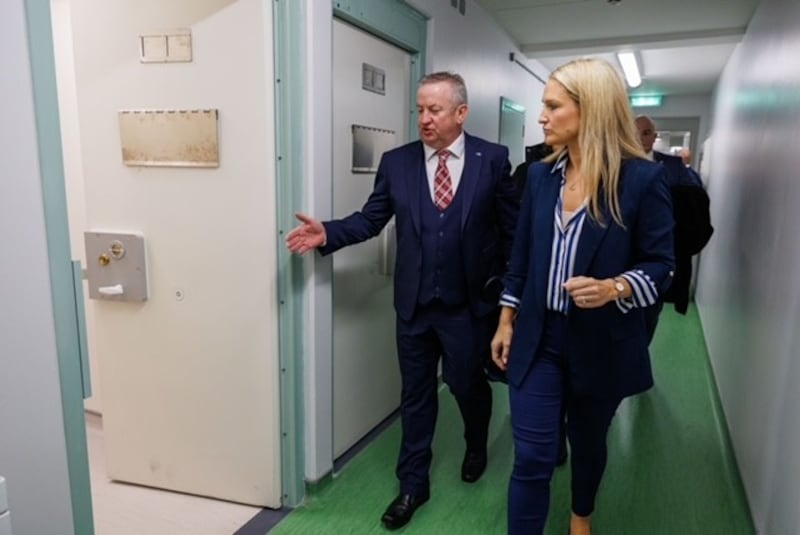Until relatively recently, Ireland had good reason to be proud of its approach to prison reform.
During the mid- to late-2010s, the country’s population continued to grow apace but prison numbers steadily declined. Between 2016 and 2017 the number of new committals dropped by 40 per cent and the system’s overall capacity hovered around 85 per cent. Things were far from perfect but this breathing room in terms of capacity in the country’s prisons increased safety and security for prison officers and inmates and allowed prisoners greater access to classes and drug treatment programmes.
Measures to bring an end finally to the dehumanising process of “slopping out” were yielding results, as were efforts to ensure every inmate had their own cell.
Non-custodial, community-based sentences and the use of temporary release were becoming more popular. Crucially, none of this had a noticeable impact on the crime rate, which held steady, or even decreased, across most categories.
READ MORE
Now, seven years later, most of those achievements have evaporated.
Prison numbers are at record levels, having breached the 5,000 mark for the first time last month. As of this week, there are 5,055 prisoners across the country’s 14 facilities, bringing the system to 112 per cent capacity. Overall, prison numbers have increased by 26 per cent in just the last five years.
Long gone are hopes for single-cell occupancy. Many prisoners now sleep on mattresses on cell floors wedged next to toilets. These cramped conditions, combined with the humid weather and increased competition for access to telephones and other facilities, make for a breeding ground for violence, according to prison sources.
Prison authorities are frantically trying to find ways to alleviate the overcrowding. This includes granting temporary release to increasing numbers of prisoners, assessing old structures for use as additional wings and installing bunk beds in cells.
The Irish Prison Service (IPS) is even examining the possibility of taking over the military prison in the Curragh Camp in Co Kildare.
How, after years of positive progress, do Irish prisons find themselves in such crisis?
There is no simple answer. An analysis of IPS data shows various factors driving the growth of the prison populations, from a rise in the number of women being sent to jail to a sharp increase in the number of suspects being remanded in custody pending trial.
Sex offences, assault and fraud
The data shows there has been a large increase in prisoners serving time for sexual offences, including rape, sexual assault and possession of child pornography. In 2014, there were 359 such inmates. Today, this category has almost doubled to 706.
Prisoners convicted of sex crimes are particularly problematic when it comes to overcrowding, as they must be held separately to other prisoners and cannot be easily moved around the system to create space.
There has also been a dramatic increase in prisoners serving term for assault and similar offences. This prisoner category has grown by 47 per cent to 693 in the last decade. There have also been sharp increases in other categories such as burglary and drug dealing.
An increasing number of people convicted of fraud are going to jail, although the numbers remain small compared with the general prison population. There are 103 inmates serving terms for fraud or deception, up from just 39 a decade ago.
At the same time, murder and other homicide offences have remained relatively steady over the last decade, despite the outbreak of the Hutch-Kinahan gangland feud, which has claimed 18 lives. There are 436 people serving terms for homicide offences compared with 431 in 2014.
Some other serious crime categories have declined slightly, including weapons possession. There are 109 prisoners convicted of this offence, down from 146 a decade ago.
Two categories have seen significant declines, although the overall numbers are small. The number of people serving time for “subversive” crimes, typically relating to republican paramilitary activity, has fallen from 58 in 2014 to just seven today.
The numbers serving sentences for falling to pay fines has fallen to zero. Many of these prisoners are automatically released on their arrival at prison to ease overcrowding.
Female prisoners
There are just under 200 women in the Irish prison system, an 84 per cent increase in 10 years. The country’s two dedicated women’s prisons are the most overcrowded in the system. The Dóchas Centre women’s prison, beside Mountjoy Prison in Dublin, is at 124 per cent capacity.
The situation in Limerick is even worse. The women’s prison there was reopened to much fanfare late last year. Each of the cells were designed for a single occupant and had a private en-suite bathroom and shower area. Eight of the units had three rooms- a livingroom/kitchen, bedroom and bathroom – all intended for one prisoner.
Today, the facility is at 150 per cent capacity, with 84 women in an institution intended for 56.

According to various studies, women are more likely to be imprisoned for relatively minor, non-violent offences.
Non-Irish prisoners
The number of non-Irish people serving prison terms has increased, from 553 in 2014 to 870 today, according to IPS data. This increase started around 2020 and tracks the increase in Ukrainian refugees and asylum seekers entering the country since 2022. Non-Irish born prisoners now make up 17.2 per cent of the prison population. According to the 2022 census, 20 per cent of the overall population in Ireland were born outside the country.
Fifty-one per cent of non-Irish born prisoners come from the EU, with another 13 per cent coming from the UK. Non-Irish prisoners are most likely to come from, in order, Poland, Britain, Romania, Lithuania and Brazil.
A prison source pointed out that foreign nationals tend to be over-represented among remand prisoners. This is because they are less likely to receive bail compared with Irish-born suspects as they have fewer ties to the country and are more likely to be judged a flight-risk.
Remand and short sentences
Remand prisoners – inmates who have been remanded in custody awaiting trial or sentence – make up another growing category, increasing 35 per cent since 2019. Suspects are remanded in custody for a number of reasons, including the seriousness of the charge, the likelihood they will abscond and the danger of them interfering with witnesses.
Cloverhill in west Dublin is the main remand prison in the State and is one of the most overcrowded in the system, at 112 per cent capacity.
[ Prisoners sleeping on matresses ‘wedged next to lavatories’ due to overcrowdingOpens in new window ]
The number of people serving sentences for less than 12 months has also crept back up, after dropping significantly during the Covid-19 pandemic. There are 437 inmates serving short sentences, or 8.6 per cent of the total population.
The Irish Penal Reform Trust (IPRT) has been calling for more alternatives to short sentences, such as community service and treatment programmes.
Reformers argue that these short prison terms are of little benefit from a rehabilitative point of view as they severely disrupt prisoners’ lives but are not long enough to allow them engage in education or drug treatment.
Recent efforts to increase the monitoring of prisoners in the community have met mixed success. In 2021, the IPS scraped a pilot programme involving the electronic tagging of prisoners, citing value-for-money concerns.
Prison authorities have been increasingly willing to use temporary release to address overcrowding. Currently 9.3 per cent (537 people) of sentenced prisoners are on temporary release, compared with 7.2 per cent pre-pandemic.
Expanding the system
In a statement, the IPS attributed overcrowding to various factors, including Ireland’s growing population and an increase in garda numbers. However, this can only be a partial explanation. Ireland’s population has grown significantly in the last five years, but nowhere near 26 per cent.
While Garda numbers have increased since 2014, they have stagnated in more recent years, with recruitment targets repeatedly missed.
The Prison Service said it is obliged to take every prisoner sent by the courts, no matter the capacity of its facilities.
It said it intends to bring 1,100 new prison spaces online in the next six years, including 170 this year. This will be done through repurposing and expanding existing accommodation.
Government figures have recently suggested a brand new prison may be needed, but no solid plans have emerged. The obvious site for this is Thornton Hall in north Co Dublin, which was previously earmarked as the location of the State’s first “super prison” before these plans were shelved during the recession.
The IPS said a new working group “on future prison capacity” is being established and it will make recommendations on the role Thornton Hall can play “in providing additional and modern prison accommodation”.
However, with the site currently being prepared for use as a large asylum seeker accommodation centre, it is unclear what role it can play in the short to medium term.
- Sign up for push alerts and have the best news, analysis and comment delivered directly to your phone
- Join The Irish Times on WhatsApp and stay up to date
- Listen to our Inside Politics podcast for the best political chat and analysis

















